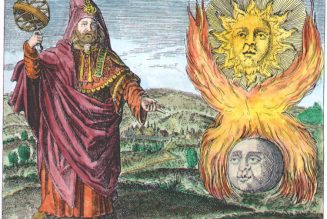An amulet is a magical object the purpose of which is to avert danger and evil influence from its possessor.
It is a protection device, as distinct from a talisman.
The latter is intended to attract some benefit to its possessor, whereas the amulet acts as an occult shield to repel.
Pliny tells us that amulet was the country folk’s name for the cyclamen, which people planted near their homes in the belief that its magical influence prevented any poisonous drug from having power to harm.
Amber was anciently called amuletum also, because it was believed to be an averter of evil influence and infection.
The word amulet is probably derived from the Latin amolior, meaning “I repel, or drive away”.
All kinds of things have been, and still are, used as amulets, all over the world.
That which they are most called on to drive away is evil influence of an occult nature, bad luck generally, or the much-dreade Evil Eye.
Brightly-polished horse-brasses are amulets for this purpose.
So are the bright blue beads popular in the Near East. In fact the colour of pure, bright blue is much esteemed in the East as an averter of evil, perhaps from its connection with heaven.
The charm bracelet, so popular today, was known in Ancient Greece.
A beautiful example of such a bracelet, delicately fashioned in solid gold, and over 2,00 years old, was shown in Brighton Museum in 1960 as part of the collection of the late Mr Moyshe Oved.
It was of exactly the same type as those worn today, consisting of a number of ‘charms’ hung from a gold chain which fastened round the wrist.
The word ‘charm’ is usually applied to these little amulets of silver or gold ; but this word is actually derived from the Latin carmen, a song, and originally meant the incantation which was chanted over an amulet or talisman, to consecrate it and endow it with magical power.
The word became transferred to the object itself, which had been ‘charmed’.
The idea that an amulet needs to be consecrated in order to be really effective, is behind the belief that a ‘lucky charm’ which someone gives you is more potent than one which you buy for yourself.
The thought of goodwill behind the gift has in a sense consecrated it.
Many of the ancient magical symbols are regarded as being both amulets and talismans, able to attract good fortune as well as repelling bad luck.
Such, for instance, are the swastika, the Ankh Cross, the five-pointed star or pentagram, and the six-pointed star or Solomon’s Seal.
These symbols are so old that their actual origin is hidden in prehistory, and the changing fortunes of nations have carried them all over the world.
The usual practice of witches, when giving someone an amulet, is to choose some small object which is strange or unusual, which makes a strong impression on the mind of the recipient.
They will then charm the object with some ceremony or formula of words, and give it to the person, usually telling them to keep it secret and not show it to anyone else.
This involves practical psychology.
People can often think of themselves as being lucky or unlucky.
If they have accepted the idea that nothing they do will ever prosper, that they are doomed to misfortune, then they are in effect beaten before they start in whatever they undertake.
Life being what it is, everyone at some time or other encounters adverse conditions and becomes prey to depression and negative thinking.
Acquiring an amulet can change the direction of their thought, restore their self-confidence, and so really and effectively change their luck.
